Inexpensive LED navigation lights, Aqua Signal & especially Marinebeam
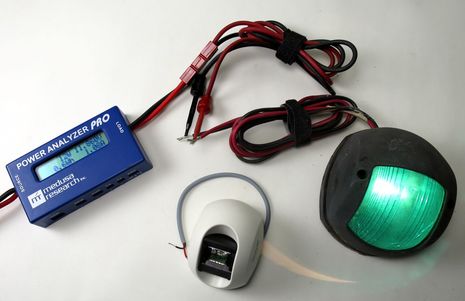 As much as I value LED lighting, I was hesitant to change Gizmo’s navigation light fixtures. Why spend the (significant) money and refit time to save power when a big alternator is always running at the same time as the running lights? But I had already removed the boat’s side light boards for refinishing last fall, and then I noticed that the cost of at least some LED nav lights has become quite reasonable. It was nearly an impulse buy when I put a pair of Aqua Signal Series 33 side lights in my Defender cart at $45 each. I’m not totally satisfied with the purchase, but I do expect the Aqua Signals to be a vast improvement over those old incandescent fixtures…
As much as I value LED lighting, I was hesitant to change Gizmo’s navigation light fixtures. Why spend the (significant) money and refit time to save power when a big alternator is always running at the same time as the running lights? But I had already removed the boat’s side light boards for refinishing last fall, and then I noticed that the cost of at least some LED nav lights has become quite reasonable. It was nearly an impulse buy when I put a pair of Aqua Signal Series 33 side lights in my Defender cart at $45 each. I’m not totally satisfied with the purchase, but I do expect the Aqua Signals to be a vast improvement over those old incandescent fixtures…
My power testing shows that the old incandescent Perko fixture using 12 watts, or over an amp of 12v current, while the LED Aqua Signal comes in at about 2 watts or 0.17 amps, even though it’s approved to meet the 2 nautical mile visibility and other requirements by about every authority possible (BSH, USCG, IMO COLREG, GL, RINA, ABYC A-16, and CE). Of course, that’s why LED running lights are a no-brainer for sailboats. Possibly more important for powerboaters is the fact that these and other LED fixtures are completely sealed and claim a lifetime starting at 20,000 hours.
A look inside the old running light reveals a typical but unreliable incandescent design. First there’s the intrinsically delicate bulb whose filament must heat way up to work, and then there’s the spring clips that have to deal with the heat and current in often damp atmospheric conditions. No wonder they often fail. This is also why LED bulb replacements are often a bad idea. You can get a Dr. LED festoon bulb that fits this fixture, but you’ll still have the clip connection to worry about, and you also won’t get maximum power efficiency (and maybe not 2nm visibility) because you’re putting an entirely different lighting technology into a fixture it wasn’t designed for. Besides, the replacement bulb costs almost as much as the entire sealed and purpose-built Aqua Signal 33 fixture! (I’ve also learned that LED interior fixtures are often a much better choice than bulb replacements.)
But then I discovered Marinebeam’s Navlight series of LED running lights. The stern light above did cost $89, as did the steaming light I also bought, but they’re better than the Aqua Signal 33 design in at least two ways. An obvious difference is that good quality 8-foot 18AWG power lead, as compared to the pathetic 7-inch lead on the Aqua Signal fixture (and hat’s off to West Marine for noting that specification when most other seller’s don’t). I’ll be cursing Aqua Signal when I have to fit the splice to that little lead into a routed pocket on the back of Gizmo’s light boards, and I also had a devil of a time getting the white trim piece off without damaging it.
Meanwhile, the Marinebeam casing snaps on and off, no problem, and the 3nm rated stern light looked very bright in my lab while drawing just 0.11 amps of power. So far, I’m really impressed with the Marinebeam design and look forward to using them. In fact, I intend to run Gizmo’s new set of LED nav lights even in daylight; I’ve always thought that had some safety value, particularly in fog, but was somewhat hesitant due to the short lifetime of those now silly-seeming filament bulbs.
Yes, it was a bit of a shopping spree, as a Navisafe 2nm Tricolor Navi Light seemed hard to pass up at Marinebeam discount. In the flesh the Navi Light seems as well designed and made as the company marketing suggests. Tapping the button let’s you fire up all three sectors, or just any single one, or just the red and green sidelights. I’ll probably use the latter mode on the bow of my rowing tender, leaving the magnetic plate fastened in place where it will automatically align the otherwise portable light, or maybe I’ll fashion a pole so I can use all three lights at once without blinding myself. In either case, it will be a vast improvement over waving a flashlight around (even if that’s legal). Marinebeam also offers a kit for legally lighting a small power boat, and I might add the adjustable strap that comes with a Navi Light means you could also wear it on your head…maybe at a beach party?


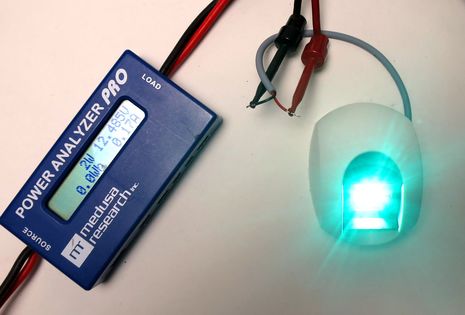
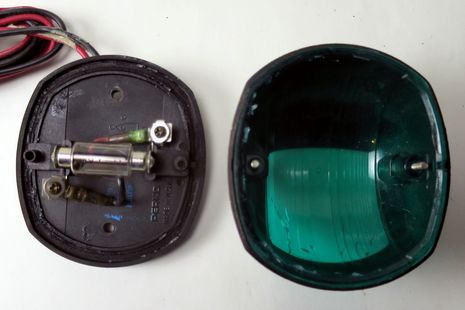
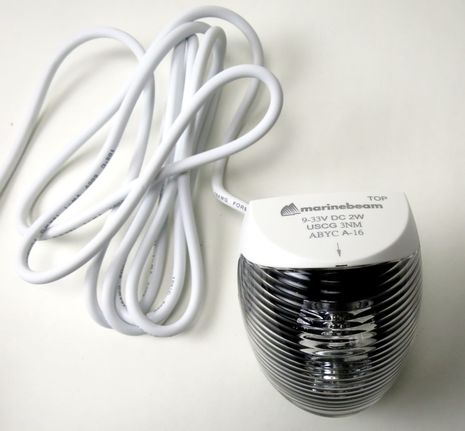
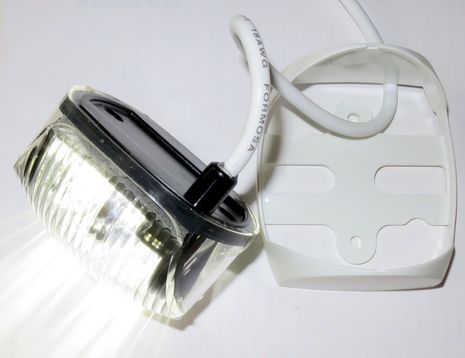
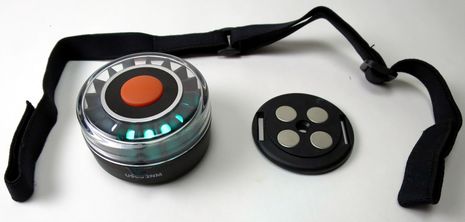
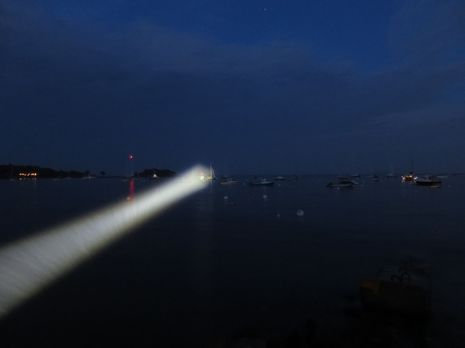


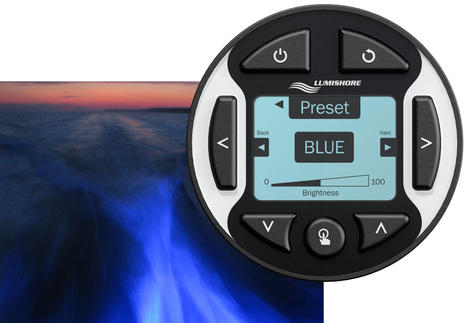







Interesting, Ben – I just (last fall) completed the changeout of most of our lights to LED – by changing the bulbs, not the fixtures — so we still have the specter of corrosion inside the fixtures. The only fixture I didn’t change out is the Series 41 “Combi Light” steaming/foredeck light – which I will eventually get to, I suppose.
I see that Aqua Signal has a direct replacement for our Series 41 side/stern lights – but even Defender’s price is a serious thump to the wallet – $200 apiece! For that, I think I’m willing to do an annual cleaning..:-) The replacement for our masthead Series 40 would appear to be their Series 34 – at $287, and doesn’t include the strobe.
For the side lights, there would also be the problem of installing the power wiring, which goes through the pulpit/pushpit tubing, and would be a major PITA to replace – and a splice inside there isn’t inspiring, either.
If I were starting from scratch, I would certainly spring for the extra reliability of the LED fixtures – but the marginal increase doesn’t seem to be worth the substantial cost of replacements.
Meanwhile, I would be happy to pitch in a small contribution (say, the cost of a 6-pack?) for a picture of Ben wearing that all-round light at a suitable public gathering..:)
For the people missing the boat on worrying about corrosion in the bulb contacts, I suggest using silicon grease on the metal contacts. LEDS seem to very resistant to vibration also.
Did you do any checking for RF noise? A lot of LED lights put out enough noise to effect VHF radios and low power FM stations.
Paul L
Thanks for the Marinebeam tip Ben. Smells good and seems reasonable priced.
I’m in the process of re-wiring a bow pulpit and replacing the bi color … snaking 16 gauge is giving me fits.
What is the gauge of the 8′ Marinebeam wiring (can’t locate this info on their site)?
Thanks
Asked and answered. 18 AWG in the text and pics.
I have a pair of Aqua Signal Series 32 side lights, now discontinued. Mine were made in October 2006 and there was evidently a Series 31 first generation LED before that. The improvements of the 33 over the 32 that I see are (1) the AWG 22 wires are now bundled in a cable and {2) there is an improved way to mount it, a mounting plate perhaps? Series 31 was just held on by one expansion screw. The other change is that Series 33 is now 12 V only, where Series 32 was 12/24 (plus or minus 20%). For those wanting 24 V, there is the high end Series 34. The odd thing is that Aqua Signal’s 2014/2015 catalog ONLY lists the Series 34 and the online stores on this side of the pond only list the Series 33.
For sailboats, watch out for the new kid on the block. The new version of their masthead tri-color is very competitive.
http://www.lunasealighting.com/products/detail/ultra-light-led-navigation-light-fixture/led-navigation-fixtures-and-bulbs
One thing to watch for on LED Nav light is a completely waterproof unit. I have had five units of OEM fail over five years in the tropic due to condensation shorting the LED’s inside the units. Unit stay sealed for around 36 months. I have gone back to Aqua Signal 55’s because it is easy to replace bulbs, clean contact than take out the whole unit to ship back to the states (from eastern Caribbean) wait for the warrant process, being without Nav lights for that period.
Unrelated question, but are the Medusa Research Power Analyzer Pro units still available? Where and how much?
Go Brighter And Save Power
Another benefit of LED’s, if you choose to use LED replacement bulbs with higher light outputs than the original incandescent bulbs, is to obtain a much brighter lighting solution inside the boats and power savings.
Normally you cannot put brighter bulbs in a fixture, if the maximum wattage was already reached, but the exception is when you put a brighter bulb in with less wattage as happens with LED technology.
The good people at Marinebeam set me up with replacement fixtures all over the boat, but inside the Salon found a specific bulb that was 30% brighter that the originals built into the ceiling, and was still a 65% power consumption reduction for each bulb in the Salon.
Roy, I don’t know about the Medusa Research unit, but Powerwerx seems to have a similar unit – and the price is reasonable: http://www.powerwerx.com/digital-meters/dc-inline-watt-meter-power-analyzer-powerpoles.html
They also offer it without the Powerpoles, if you prefer..:-)
Byron,
I think you mean OGM lights – the ones that have a flat lens and come with a stainless bracket? If so, I had the same experience. In fact, OGM replaced mine a few times and still the same condensation under the lens. Water in light fixtures is not a good combination. I find it very unfortunate because when new the OGM’s had a bright, penetrating output that was great in fog. Still have them onboard, but will replace these very expensive navigation lights with another brand when they start to fail.
I would like to pick up on Paul L’s comment about electrical noise produced by some LED Navigation Lights. I was surprised that no one replied to this and I have been doing my own investigations after a report on the YBW forum of detrimental affects on AIS reception, when an LED Navigation Light was turned on.
http://www.ybw.com/forums/showthread.php?391533-LED-masthead-lights-interfere-with-the-AIS-reception
Has anyone else experienced this, either on AIS, VHF or DSC reception ?
I will be posting the results of my tests next week.
I am about to install a pair of the Series 33 sidelights, to replace the original Hella units that have a tendency to lose their covers in heavy weather. The guts then immediately turn to rust.
It would be nice if the manufacturers could agree on a hole spacing for lights, so that it is not necessary to drill into vertical SS mounting plates. I will use some pieces of Starboard to avoid this, but it will look like hell.
Now, if only the sailboat masthead/anchor lights didn’t cost so much. The Lunasea units look very tempting – maybe when I have the mast down to replace the rigging…
Paul,
Yes you are correct on the manufacturer.
I just installed a Hella NaviLED Trio, to replace an AquaSignal LED Tricolour fixture. The Aquasignal Series 34 lamp’s mounting is just not very sturdy. The problem is that big nut they use to fix the lamp to the base.
The Hella LEDs are really good, but are more expensive. K2W lights are also worth a look.
Thanks, Phillip, but I’m confused about your Aqua Signal Series 34 critique. The 34 design seems to be the same physical design as the 33 Series and there is no nut involved. The backing plate and light are one sturdy polyamide part. I’m looking at a 33 with the cosmetic cover off and I can’t imagine how it would come apart. You can see some detail of the back plate in this PDF:
http://www.aquasignal.com.au/wp-content/uploads/AquaSignal_Series34.pdf
The only difference between the 33 and 34 Series seems to be that the 34 can be used with 12 or 24 volts while the 33 is only 12v.
Folks worried about interfenence in nearby antennas — which I don’t think happens much anymore — should note that West Marine claims that both the Aqua Signal 33 and 34 Series are “Tested and certified for electromagnetic interference.”
But then again West specifies the Series 34 power lead as 39 inches while the PDF above describes it as the same cheap, undersized 200mm 22AWG lead seen on the Series 33.
Thank you, Hartley. I sent off for one this morning.
Yes, thanks to Hartley for finding the Turnigy Power Analyzer. It looks good but note that the similar Watt’s Up and Doc Wattson models are still available:
http://www.rc-electronics-usa.com/electrical-test-equipment.html
A neat thing about the Medusa I have is the USB port and analysis software, but the device not made anymore and I haven’t used the PC output in quite a while anyway:
https://panbo.com/archives/2010/03/medusa_power_analyzer_pro_some_results.html
Regarding the question about the potential for RF noise on Marinebeam navigation lights: While a quick glance at the product info on the product page will answer that question, I will reiterate it here to answer the specific question.
The Marinebeam Navlight Series is not only conforming to the European general lighting Electromagnetic Compatibility (EMC) standards EN55022 and EN61547, but also the very comprehensive and specific IEC60945 standard, which specifically relates to electromagnetic immunity and compatibility with maritime navigation and radio-communication equipment and systems. Testing and certification under these standards confirms that the lamps are well below the thresholds for all of these standards, so RF noise is not an issue with these lamps.
Jeff Field
http://www.marinebeam.com
Hi Ben – I think Phillip is actually referring to the Aqua Signal Series 34 masthead tri-color, which has what looks like a different construction. It looks a lot like the old Series 40 “Quick-fit”, with a large threaded locking ring or nut to hold it down. Oddly, Aqua Signal’s web page doesn’t show them, but Defender’s catalog does.
On the power analyzers, the units look very similar – and the very similar pricing seems to suggest them may all originate in the same factory in the Far East..:-) I took a look on eBay, and it seems you can buy something that looks similar for as little as $15, though there doesn’t appear to be any sign of a warrantee at that price.
I also noted that there are USB current meters being sold there, too – just the ticket for seeing what your phone charger or iPad is really drawing – at 3 or 4 dollars, I might buy one just for fun.
Most of the MarineBeam LEDs I have bought had no noticeable RF. The exception to that are the MR16 replacement bulbs, that have a significant RF noise on both VHF and FM.
Paul L
Recent testing that I have now completed of various LED Bulbs would support Paul L’s comments.
In my tests a small number of LED Navigation lights/bulbs were found to potentially cause interference with AIS reception, if the cable to the light was run directly alongside the VHF antenna cable. The electrical noise was generated by the switch mode regulator in the LED Navigation bulb and we would recommend to all manufacturers of these lights to look closely at using lower frequency switch mode regulators and fitting suppression filters.
The noise was pre-dominantly radiated (through the air between the cables), rather than conducted (through the wiring) and routing the LED Navigation Light cable away from the VHF Antenna cable had the biggest positive affect on reception.
Differences were found between manufacturers and even between different LED Light models in the same manufacturer’s range, so we would recommend checking an LED light before fitting them on a boat with an AIS system installed. This can be done by placing a coil of LED Light power cable alongside the AIS VHF antenna cable and checking if the RSSI figure increases or checking the number of AIS targets with the LED Light ON and then when you turn the LED Light OFF.
Best regards
PAUL SUMPNER (Digital Yacht)
I finally installed the AS 33 sidelights, and they are very nice. It made me think of another opportunity for a creative electrical supply company to make money – invent a butt connector that joins 22ga wires to 14ga wires, is waterproof and secure when made up, and is easy to use when perched on the bow of a sailboat with a strong breeze blowing.
I can forsee lots of people replacing old incandescent fixtures with LED ones, and they will all have this problem. The existing wiring is rather large, to carry the current, and no one wants to have to replace the wiring. The new LED lights have tiny wires, because they don’t need much current. The butt splices will be quite “exposed” to the seas and the weather. How to join the two together?
Yeah, it is easy to say “solder and shrinkwrap”, and that may be possible inside the boat. What do you do at the top of the mast, or outside on the bow pulpit, where you need one hand to steady yourself, and don’t have three extra hands available to hold the wiring to solder them?
I used some Scotchlok connectors, and wrapped them in butyl tape and then silicone self-amalgamating tape. It is ugly, but it works, and should be waterproof for a while, till the UV kills it.
…Or the LED light suppliers could just use 14ga leads…
Hi,
I just something like this: http://catalog.hella.com/catalog/product/view/id/202431/?___SID=U
It solderes, shrinks and seals in one step. Just use a heatgun. I often use my PyroPen for that. Works like a charm and are waterproof.
Thanks, Philipp. I found something similar available here: http://goo.gl/Wht2fg
That page also links to a video showing how they’re used. I didn’t know about “Heat Shrink Solder Butt Connectors” but look effective. However, I’m not sure they’re ABYC legal and they also don’t take care of the mismatched wire gauge problem RXC wrote about.
Of course I am not sure about the ABYC requirements, but I think that since both wires get soldered together and the shrink tubing is flexible enough to accommodate both wire sizes it is a fairly good solution to the problem. Anything that crimps is not as flexible when it comes to different wire sizes.
Of course that does not fix the basic problem. I also think it would be better for manufacturers to use bigger gauge wire. What they use is just too small for any decent installation. Those small wires are sensitive and hard to come by in a “usable” state, like double insulated types and such.
I have tried to use the solder tubes. Home Depot sells them, and I thought they might be useful, but when I tried to use them to reconnect my SSB antenna wire, It took several tries to get it to work. Someday you should try to use a heat gun while standing on top of a stern arch, holding two wires together inside a vinyl tube. The wires were the same size, but it was quite awkward. Especially with the wind blowing enough to defeat the heat gun.
I thought about them for the lights, but I didn’t have enough hands to make it work.
Is there a good solution for rail mounting the Marinebeam bi-color bow light and the stern light? I currently have the Aqua-Signal Series 25 lights which have a very nicely integrated rail mounting system. Is there any possibility that the Marinebeam lights fit in the Aqua-Signal rail mounting system?
Thanks!
Eric
Practical Sailor did RF interference measurements on interior LED light fittings in a recent issue. Noise is still an issue for some products. Presumably masthead lamps for sailboats will need extremely scrupulous attention to noise emissions, being immediately proximate to VHF antennas as they so frequently are. Probably a good idea to test on the ground w/a handheld VHF regardless of manufacturer claims; samples can vary.
Handhelds make great informal testing tools for spurious emissions. Find a weak weather broadcast, bring the antenna into proximity w/fixture(also try this with chartplotters and other stuff at nav station– you might be unpleasantly surprised).
Update to my earlier post:
I corresponded with Nathan at Marinebeam – they currently offer a bracket for mast mounting but nothing yet for rail mounting. I compared the MarineBeam dimensioned drawings against the AquaSignal Series 25 rail mounting bracket – while the light housing have similar shapes, the sizes are sufficiently different that it does not look like the MarineBeam light can use the AquaSignal mount.
Eric
I’m about to replace the Hella 2984 series naav lights on Barbara with LED fixtures. I am tired of coming in from sea on a dirty night and finding that one of my lights is out — either the bulb gone or corrosion. One advantagge is that the same size unit will give me a 3-mile light instead of 2.
I just wish that they were bolt-in compatible instead of requiring new scerw holes. I think Hella missed the boat here in not providing an easy upgrade path.
Hi Ben Ellison
My name is Carmen Regalado, Sales Manager at Perko
Working navigation lights are essential to our safety at sea and Perko’s commitment to safety is well known and respected. We have been manufacturing the incandescent 0170 Series (the one in your picture)lights for over 30 years. They are sold worldwide. Our records indicate that less than 20 of our 0170 series lights have failed in the field in the past 6 years. Note that there are over 70 individual lights in the 0170 Series, which is used on commercial working boats and government patrol boats in addition to recreational boats. Part of the reason the 0170 Series incandescent lights perform well is that, like all Perko lights, they are made in America using quality components. In addition, we gold plate the contacts of our lights, something no one else does.
You are comparing our 0170 Series incandescent light to a LED light made by another manufacturer. Please note that the 0170 series is also available with LED light engines. There are many reasons why someone would still choose an incandescent light. These include a much lower initial cost, the ease of replacing individual component parts in the event of a failure from damage, corrosion or simply age, and the fact that most boaters rarely use their boats at night.
Also note that navigation lights are certified with specific bulbs. Changing a bulb to a different brand or light source (e.g. incandescent bulb to LED bulb) will, in nearly every case, void the certification and result in a light whose performance characteristics are unknown. As a safety device, that is something we never recommend.
Perko has been involved in lighting for vessels for over 100 years. If you check our website we offer more than incandescent lights. You will find LED lights of all shapes and sizes, certified to meet USCG regulations.
Best regards,
Ben,
Which lights did you end up installing – the Marinebeam or the AquaSignal?
I know it’s been less than a year, but how are they holding up? I suddenly find myself in the market for new stern and sidelights.
I installed Lopolights about six years ago and both of them decided to give up on me this past weekend in some dirty weather in the middle of the night.
I’ve since read online that they have pretty poor power filtering/conditioning for the little microprocessor in them and as such don’t always get on with Mr. Alternator.
Both, Tim. AquaSignal side lights and Marine Beam steaming (haven’t switched the stern light as the wiring problem is significant).
All are working fine and I’ve used them quite a bit as I often run them all day since there is no real bulb lifetime issue. But if I could have a do over I’d get the Mainebeam sidelights too. The product line is impressive in quality, design, install ease, and value.
Ben, Tim, for what it’s worth I installed the AquaSignal lights after reading this article and have been happy with them. No issues. Good price.
Well, my OGM navigation lights have been in for a few years. Almost immediately after initial installation they developed condensation under the lens. This was not just one light, but all of them. It was only a matter of time before the condensation and electrical components would result in failure. So, today they started to fail. (8/2015)
I decided to give Marinebeam a close look so ordered only the stern light. When it arrived I found the build quality excellent so placed a second order for the port and starboard lights. The Marinebeam Nav lights have what seems to be a really bright output which I like a lot – I think it makes me look like a bigger boat then I am. While I was at it, I also ordered a new Marinebeam Steaming/Foredeck LED light. The old steaming fixture was a Hella which had a burned out steaming bulb that is very expensive to replace.
One note: The Mairnebeam nav light has a short protruding plastic wire reinforcement on the back to support making the wire entry waterproof. This is a good thing, however, it may require drilling a hole in whatever surface you mount it to so the light mounts flush. Not a big deal for me, but something you should be aware of and plan for.
The protrusion on the back bottom corner can be a problem. It is for me. I didn’t catch it before ordering. You can’t flush mount without drilling a new hole in an exact position. Something not always possible. Would have been better if wire exited the bottom or the back piece had enough depth to route the wire to the bottom or anywhere out of the back.
Yes, I agree. This generation of lights presents problems when mounting flush. It would be nice to see the design change in the next generation of Nav lights.
In my case, I have to mount these to a thick stainless steel plate welded on the bow pulpit. I used black 1/2″ Starboard to cut out a mount that exactly matches the footprint of the light. The Starboard has a slot cut for the wire to lead up and into the bow pulpit pipe. This made for a interesting project to overcome the protruding plastic wire support problem. As long as no moisture get into the light I’m fine with the extra work. The wire looks like it’s really well sealed.
Resurrecting this post/thread from last year. We just arrived in the Southern Chesapeake (thru TWO nasty thunderstorms!) and I forgot & left my running lights on after we tied up. When I walked back from the office, my port sidelight was flashing! Maybe 1-2 seconds on and 1-2 seconds off (somewhat irregular) – looking closer, the “off” state was still slightly lit, just dim. I have AquaSignal 40 series, and I had replaced the original incandescent bulbs with LEDs over the last couple of years. I opened the fixture and removed the Dr. LED bulb and replaced it with a Marinebeam “Tower” red bulb – which works great and DOESN’T flash! Putting 12V on the bulb at the nav station verified the malfunction – after a couple minutes, it starts flashing! (voltages inside the fixture were 100% normal). I think I’ll order a spare from Marinebeam – and they cost less than half what that Dr. LED bulb did! Defender still stocks the Dr. LED I had (they call it a “Polar Star Series 40”) so it isn’t one of the ancient ones.
After less than 2 years, my Auqu Signal Series 33 port/starboard LED nav lights burned out. Ensuring power was at the light, they are either burned out or something inside the bedded connection has failed.
Has anyone else experienced this?
Well, it looks like the lifetime of the AS Series lights is about 7 years. My green stbd light, which was installed in 2016 (see comments above), finally died. I traced all the wiring to see if it was a bad connection, but in the end it was the light. I am going to order a new green one – WM is having a clearance sale on the green AS Series 33 lights, and if it lasts another 7 years, I will be satisfied. Don’t know when the red one will die – I will likely have to pay full price for it. Much longer lifespan than the lights that came with the boat. They used to last only as long as it took to bury the bow in a nice-sized wave.
Thanks for the report, rxc! It motivated me to check Gizmo’s nav lights and happy to report that both Aqua Signal Series 33 side lights are still running fine nearly nine years after installation. Admittedly I haven’t run much at night in recent years, and the boat didn’t even get launched in 2021, but then again I’m in the habit of turning on the running lights whenever I’m underway as another line of defense if thick Maine fog rolls in. So hopefully you and Jim Anderson experienced exceptions to what should be a very long LED life span.
I was also pleased to see that Gizmo’s Marine Beam steaming light is still exceptionally bright after the same time period, and also that Marine Beam has added a nifty combo steaming/deck light to the same series: https://store.marinebeam.com/led-masthead-foredeck-combination-light/
Meanwhile, the boat’s old AS incandescent stern light did not go on until I tapped it with a screwdriver, and I cursed myself for letting the Marine Beam replacement slip down the to-do list for so many years. The cable access is tricky, but back up the list it went 😉
I wonder whether it is all about the exposure. On sailboats, these lights are installed in a place that is always wet, with bow-burying events very common, That is what destroyed the original Hella lights. I doubt that yours get buried very often, . I will take apart the one that failed to see what happened. My first impression is that the cable into the potted section is burnt. Possibly shorted by water. But not damaged enough to trip the breaker.
I wonder whether AS will be coming out with a similar low-price model. The Series 34 looks like it is exactly the same, but at a much higher price. I have seen some comments that the only difference is that the Series 34 can take 12-24V, rather than just 12 V.
Well, how about exposure to 12v power anomalies? I think that these fixtures are quite well sealed, but they do contain possibly sensitive electronics. Also, note Marine Beam’s claim about the power conditioning used in all its own brand LED fixtures:
“Our LED navigation lights have our integrated internal Constant-Current chipset, so they can operate at voltages from 9-33VDC. This means they are great for both 12VDC and 24VDC applications. This also provides protection from over-voltage conditions, transient surges, and provides for consistent output and safety even at very low battery levels.”
I think that this or similar is commonly done in quality LED fixtures, and may explain the extra cost of the AS Series 34.
My Sea Ray boat had platforms molded in the deck for “teardrop” shaped deck mount bow lights. Perko still offers the original halogen fixtures but their 3rd attempt at LED replacement fixtures is still on hold. Have you had any experience with the Austrailian Hella lighting products? They make a sealed LED fixture that would fit.
I ordered a SeaView masthead light for my SeaView radar mount. They have dropped Perko for replacement fixtures.
I may try the Perko “European” stern light replacement for their classic 0946 Halogen fixture. I like chrome plated brass for durability.
Hi David, I have not used Hella lights but the company has a good brand reputation and lots of experience manufacturing marine LED fixtures, especially nav lights. I also note two important claims on their web site:
1. “Advanced Multivolt” circuitry that means the LED is consistently bright despite a wide range of input voltages and also protected from spikes and reverse polarity.
2. “Their electrical circuits contain components that suppress possible interference, both emission as well as susceptibility to emissions, to the limits prescribed in international standards.”
These are important details often not done well in LED bulb replacements and likely some LED fixtures. Meanwhile, I do not know where Sea View is sourcing its LED fixtures, but do know them to be a highly reputable operation. Finally, I think that key to nav light durability is a properly designed and fully sealed LED fixture while the case material, plastic or metal, is secondary.
I recently checked all the lights on my boat and found both bow nav lights out. …
AS 33s. There were installed at least 10 yrs ago, but I doubt they had 200 actual hours of use, as opposed to the 20k advertised life. Bow rail mounted, no sign of corrosion or water penetration. Brought one home and connected to 12v source, still no light but unit got warm, indicating some current flow. I’ll replace with the same as they fit the mounting pads and good price.